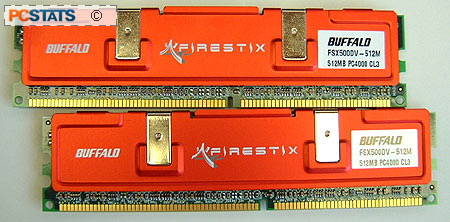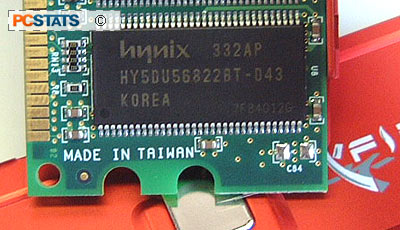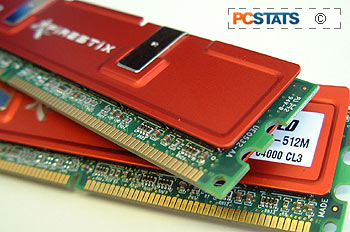Buffalo Firestix FSX5000V DDR Memory Review
Even with all the changes occuring on the
Intel platform this summer (PCI-Express, DDR2 RAM, socket 775 CPUs, etc.) DDR memory's future is still very bright. After all AMD systems from the AthlonXP through to
the Athlon64 use DDR, as do all socket 478 Intel-based motherboards. With this in mind, there are still plenty of enthusiasts hungry for fast DDR that overclocks even faster still!
Buffalo Technology is gearing up for some tough
competition in the high-end memory market, and their secret weapons are the new
dual channel DDR Buffalo
Firestix modules.
Buffalo's new series of DDR RAM comes with
a snazzy new name, some bright red heatspreaders, and modules
like the ones we are testing today which are rated to run at 250 MHz, while
maintaining 3-4-4-8 memory timings, at a voltage of 2.7V. For this review
PCstats is testing a pair of 512MB PC4000 CL3 DDR modules Buffalo call the
FSX5000V-512M.

Consider the bright red heatspreaders as nice protection for the electrical components on the PCB. Heatspreaders really do very little for memory that runs at stock speeds.
With the heatspreaders carefully removed, we find that Buffalo are using Hynix D43
memory DRAM on these Firestix PC4000 DIMM's. Most other memory makers are also using this particular DRAM because
it is pretty fast. This means that for the Buffalo Firestix to pull ahead of the
pack, the PCB these memory DRAMs are soldered onto better be something
special!
 According to Hynix, the HY5DU568228T-D43 DRAM is only rated
to run at 200 MHz with 3-3-3-8 memory timings, at 2.5V. Again, most manufacturers have
figured out that raising the voltages just a bit, they can drastically
increase the clock rate! It looks like manufacturers are now employing
overclockers tricks to get higher speeds. ;-) According to Hynix, the HY5DU568228T-D43 DRAM is only rated
to run at 200 MHz with 3-3-3-8 memory timings, at 2.5V. Again, most manufacturers have
figured out that raising the voltages just a bit, they can drastically
increase the clock rate! It looks like manufacturers are now employing
overclockers tricks to get higher speeds. ;-)
Those who read PCStats regularly know that all current high speed
DDR memory is built specifically for Pentium 4 systems. Knowing that, weren't
anticipating anything out of the ordinary on the Athlon64 3200+ (socket 754) test system.
However, that didn't stop us from trying, so the first thing we did was to run the memory with aggressive timings at 200 MHz,
and that was a bad move. Even tightening the Firestix up to 2.5-3-3-7 caused the system
fail POST. After lowering the timings back to default, the Athlon64 system came back to
life. The Firestix were benchmarked with 3-4-4-8 timings for all tests on the Athlon64 system... now
onto the overclocking!
Overclocking
with Buffalo's Firestix DDR
 Lowering the multiplier to 8x, we began to raise the motherboard
clock speed slowly to 212 MHz. Next, the memory voltage was increased to 2.7V in order to stabilize
things, and on we went.... but the Athlon64 overclocking adventure came to
an abrupt halt at 214 MHz. Even raising the voltage to 2.8V didn't help the situation,
the memory had simply hit the wall. Lowering the multiplier to 8x, we began to raise the motherboard
clock speed slowly to 212 MHz. Next, the memory voltage was increased to 2.7V in order to stabilize
things, and on we went.... but the Athlon64 overclocking adventure came to
an abrupt halt at 214 MHz. Even raising the voltage to 2.8V didn't help the situation,
the memory had simply hit the wall.
With the knowledge that the Buffalo Firestix are
specifically built to excel on an Intel Pentium 4 system, we had higher expectations for the Firestix FSX5000V
DDR in the next round of tests. Just for fun I again tried to tighten
the timings, but the best the Firestix could handle was 3-3-3-8 at 200 MHz. With virtually
no performance difference between 3-3-3-8 and 3-4-4-8, we left the memory at
stock timings and started to overclock.
The Buffalo Firestix showed some instability at 205 MHz FSB,
but jacking up the memory voltage to 2.7V solved that issue. After that little bump, the
overclocking went by pretty smoothly, and we were able to reach the Firestix 250
MHz rating quite easily. At 255 MHz the voltage was increased to 2.8V, and after
that the Firestix were pushed all the way to 261 MHz! Next up, the
benchmarks!
|

